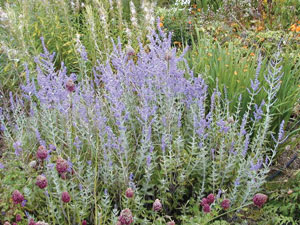5/24/2011
The Merits of Perovskia
Pierre Bennerup

Russian sage is neither Russian nor a sage. It’s native from Afghanistan to Nepal, although named for a Russian botanist named Perovski. It’s not a good substitute for garden sage,
Salvia officinalis. It’s also in the mint family,
Labiatae, but if it’s eatable, meaning non-toxic, it certainly isn’t edible, meaning tasty or nutritious. Nonetheless, it’s one of the most useful and beautiful plants in the perennial garden.
First, it’s a ”sanitizing” plant. The late, great gardener, Fred McGourty of Hillside Gardens in Norfolk, Connecticut, often used that term to describe plants that would divide clashing colors, thus making them less jarring to the eyes. As an example, the color orange rarely blends well with magenta. Placing a sanitizing plant such as perovskia between them greatly reduces the “seared eyeball” response, a description coined by another great gardener, Thomas Reinhardt, who now gardens on the border of Tuscany and Umbria.
Second, perovskia is a great “partner” plant. As a late summer- and fall-blooming plant it combines perfectly with chrysanthemums or Japanese anemones. In the fall we often see mono-colored drifts of chrysanthemums in public and commercial plantings. Interspersing these installations with Russian sage would add a new color (there are no blue chrysanthemums) plus definition to an otherwise amorphous mass of sameness. It also partners well with ornamental grasses such as miscanthus, panicum and pennisetum, looking great in large commercial plantings, highway dividers and so on.
Third, perovskia gives a strong element of verticality to any flower garden. It breaks up drifts of round or flat foliaged forms, offering a bold center of focus throughout the growing season. Its silver-gray foliage strikingly sets it off from the predominantly green leaves of most garden plants.
Fourth, its silver-gray foliage and blue flowers tend to cool down the hot colors of high season, thus giving us a psychological sense of coolness in the dog days of summer. It’s a relatively carefree substitute for lavenders that many people find difficult to grow. Their flower and foliage colors are quite similar, but Russian sage blooms later and longer than lavender, from August to October.
Culture and varieties
Russian sage is hardy from Zones 5 to 9. It must be grown in well-drained soil, such as sandy loam, and performs best in full sun. Any amount of shade will tend to make it floppy. Although perovskia is technically a deciduous shrub, it performs best if cut back to near ground level every fall or early spring. Propagation is by top cutting in spring. Young plants become salable by the summer of the following year.
In the trade, the most common species of Russian sage is
atriplicifolia. There are several listed cultivars: Blue Spire, Filigran, Little Spire and Longin are some. Filigran is possibly a cross between
atriplicifolia and
abrotanoides, another species from the same region but rarely seen in the trade. There is no visible color difference between the various forms, all being sky blue. There is a minor difference between height and leaf size: Little Spire being 6 to 10 in. shorter; Filigran having finer texture. All forms are quite columnar or vase shaped, about 3 to 4 ft. tall at mature height.
All Russian sages are remarkably disease free, pest free and drought tolerant. Better yet, deer and other “varmints” despise them. Like most gray-foliaged plants, they prefer good drainage, sun and neutral to slightly alkaline soil. Given those conditions, perovskia has become a reliable and handsome workhorse in the landscape, suitable to many locations in almost every state.
GT
Pierre Bennerup is president of Sunny Border Nurseries (www.sunnyborder.com) in Kensington, Connecticut.